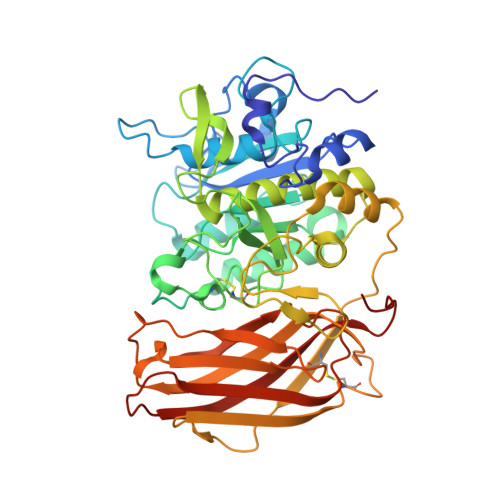Dichlorophenylpyridine-Based Molecules Inhibit Furin through an Induced-Fit Mechanism.
Dahms, S.O., Schnapp, G., Winter, M., Buttner, F.H., Schleputz, M., Gnamm, C., Pautsch, A., Brandstetter, H.(2022) ACS Chem Biol 17: 816-821
- PubMed: 35377598
- DOI: https://doi.org/10.1021/acschembio.2c00103
- Primary Citation of Related Structures:
7QXY, 7QXZ, 7QY0, 7QY1, 7QY2 - PubMed Abstract:
Inhibitors of the proprotein convertase furin might serve as broad-spectrum antiviral therapeutics. High cellular potency and antiviral activity against acute respiratory syndrome coronavirus 2 (SARS-CoV-2) have been reported for (3,5-dichlorophenyl)pyridine-derived furin inhibitors. Here we characterized the binding mechanism of this inhibitor class using structural, biophysical, and biochemical methods. We established a MALDI-TOF-MS-based furin activity assay, determined IC 50 values, and solved X-ray structures of (3,5-dichlorophenyl)pyridine-derived compounds in complex with furin. The inhibitors induced a substantial conformational rearrangement of the active-site cleft by exposing a central buried tryptophan residue. These changes formed an extended hydrophobic surface patch where the 3,5-dichlorophenyl moiety of the inhibitors was inserted into a newly formed binding pocket. Consistent with these structural rearrangements, we observed slow off-rate binding kinetics and strong structural stabilization in surface plasmon resonance and differential scanning fluorimetry experiments, respectively. The discovered furin conformation offers new opportunities for structure-based drug discovery.
Organizational Affiliation:
Department of Biosciences and Medical Biology, University of Salzburg, Hellbrunner Stra?e 34, A-5020 Salzburg, Austria.


















